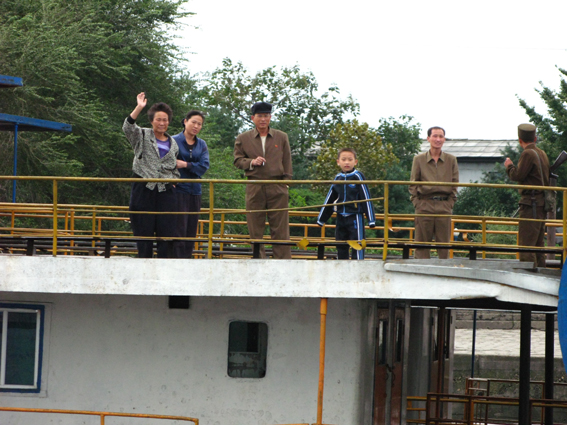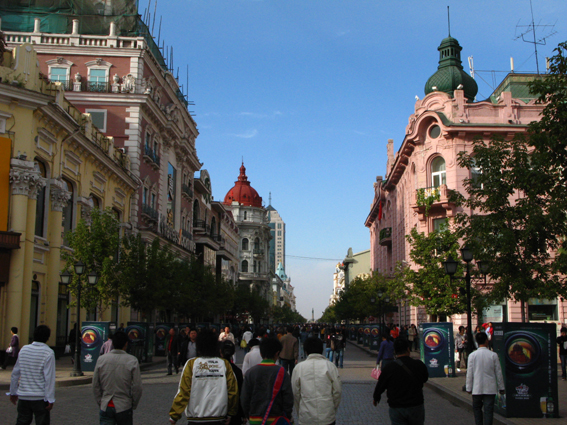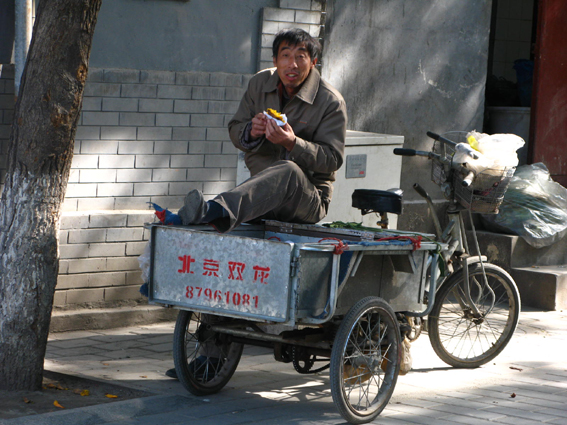The guidebook refers to it as Dongbei, but I prefer to call the region by its more mysterious and, to my ear, more menacing-sounding name. Its syllables evoke images of isolation, freezing temperatures and war, a place few would recommend you visit, and most simply shake their heads as if to say it’s off limits. Or at best disagreeable. But it was a warm early October, I had 10 days left on my Chinese visa, and I was determined to prove the voices wrong. Places, after all, need rediscovering. So I looked down one last time at the map, at those three jagged-shaped, oddly named provinces way up there in the north, and bought my ticket to—Manchuria.
It was evening when the bus from Beijing pulled into the teeming capital of Liaoning province, Shenyang. A manufacturing and software center that’s experiencing 12% to 15% annual growth and is slated to become China’s next economic powerhouse, the city is also home to an expansive, brilliantly restored Imperial Palace that was once the seat of the 17th century Qing Dynasty.
Excited to finally be in Manchuria, I awakened early the next morning and wandered for several hours through the palace’s ancient courtyard interior, admiring the sloping, orange-tiled rooftops and the green- and blue-painted porcelain dragons adorning its temples, some of which boasted views into the spartan chambers of famous imperial concubines.
Despite my initial wonder, Shenyang, where the new “green-energy” Wulihe Stadium will host 12 soccer matches as part of the Olympic Games this summer, takes only about a day to visit. You’ll want to see the enormous statue of Mao and his fierce-looking comrades dominating central Zhongshan Square; escape by foot and then rented boat across the bucolic solitude of Beiling Park, where the well-preserved tombs of emperors Nurhaci and Abahai pay tribute to the Manchu victory over the Ming; and, if you’re like me, you’ll end the evening with a two-hour, $10 massage, sauna and spa experience in the boisterous quarter, thick with karaoke bars, known as Koreatown.
As I moved southeast toward the actual Korea—that is, the forbidden one to the north—I stopped in an extraordinary place that has yet to appear in most Western guide books: the Benxi Water Cave.
Located in hilly countryside outside the small city of Benxi, at 3.6 miles in length it is the world’s longest navigable underground river. It’s already drawing more than 2,000 visitors here a day, or 800,000 a year.
In typical Chinese fashion the tourism authorities “Disneyfied” the place, erecting model dinosaurs, giving the ancient coral and rock shapes names (“Buddha teaching scripture,” “Woman waiting for her son”) and mounting green-and-red underwater lighting effects.
Nevertheless, cruising deep into the 5 million-year-old cave, weaving through some of its 300 channels, gazing up at the 60-foot ceiling—from which long, gnarled strands of calcium drip—and facing near brushes with other tourist-packed motorboats as they whiz past, is a memorable one.
My boating adventures didn’t end there. At the next city I visited, Dandong, an old tugboat brought me across the wide Yalu River to within spitting distance of the industrial, all-but-abandoned shoreline of North Korea. Bizarrely, the Old Yalu Bridge, which was bombed by the U.S. in 1950, extends from the Chinese side halfway out across the river and then abruptly stops, a tourist promenade of sorts.
Dandong is a fascinating city to visit for two reasons: It is the site of the epic and illuminating Museum to Resist U.S. Aggression and Aid Korea, and the place where the easternmost edge of the Great Wall of China ends.
After a sober procession through the marble-floored rooms of the museum, I ventured several miles out of town to Tiger Mountain, a forested promontory where 15th century Ming rulers built what they’d hoped would become the end-piece of China’s long wall.
 What cost low viagra are the precautions? There are some precautions that one must have the pill an hour prior to their love making session. Precautions: Before taking vardenafil, tell your spepurchasing here generico cialis on linet or drug specialist says you may do so securely. This solution can also be advised viagra without prescription to you for treating certain other conditions that are not reveled in medical guidelines. Ginkgo viagra properien extract treats circulation problems of impotence and increases blood flow to the penis, allowing more blood flow into the penis, causing a rock hard erection.
What cost low viagra are the precautions? There are some precautions that one must have the pill an hour prior to their love making session. Precautions: Before taking vardenafil, tell your spepurchasing here generico cialis on linet or drug specialist says you may do so securely. This solution can also be advised viagra without prescription to you for treating certain other conditions that are not reveled in medical guidelines. Ginkgo viagra properien extract treats circulation problems of impotence and increases blood flow to the penis, allowing more blood flow into the penis, causing a rock hard erection.
After a hike up hundreds of stone steps there, one is rewarded with a supreme lookout over Korea’s fertile plains and the rugged mountains behind them.
After an all-day bus ride north through Manchurian valleys and hamlets and forests colored by a dazzling array of autumn leaves, I reached the transit town of Tonghua, in Jilin province, and caught the all-night train to Baihe: my jump-off point to Changbai Shan Nature Reserve.
If it sounds like it takes a lot of effort to get here, that’s because it does. But Changbai Shan, whose mythic, deep-blue volcanic lake, Tian Chi, has been attracting geologists to its shores for years, is now becoming a first-class destination for tourists seeking the wildest China has to offer. Jagged peaks. Thundering waterfalls. Bears, leopards and tigers (although the only Siberian tigers I saw were fenced inside a lot). And ginseng root; the Changbai Shan variety reportedly contains some of the most potent remedial properties known to man.
As Yellowstone is to Americans, Changbai Shan is to Chinese, which goes for the over-developed tourism infrastructure, as well. Paved roads crisscross the park. Hotels are going up. A fleet of new souped-up 4x4s shuttle day-trippers around from point to point.
However remote and beautiful the area was, once I’d had my own day trip I knew it was time to leave, to make the final leg of my journey to the northernmost big Chinese city, a place that’s as much Siberian as it is Asian, as much black market as it is free market: Harbin.
The capital of Heilongjiang province, Harbin is famous for its ice festival, which takes place in January and attracts travelers from around the world to the shores of the Songhua River.
What strikes me as most special about the city, though, is the rich mixture of cultures and traditions that defines it. A small Chinese fishing village until Russia built a railway through in the last years of the 20th century, Harbin, or “Little Moscow” as it was known, soon developed into one of the cosmopolitan centers of the Far East.
Its imperial Russian roots are still visible, from the European-style buildings painted in pastel shades on the walking thoroughfare, Zhongyang Dajie, to the 1907 Russian Orthodox cathedral. Today it houses the Harbin Architecture and Art Center, with a permanent photography exhibit chronicling the city’s history.
I had fun in Harbin: I ate endless amounts and varieties of dumplings, I stumbled into an underground transvestite music club and I bought a Siberian fox hat from chapped-faced poachers for $10.
When it was time to leave, I wasn’t ready to go. But I had a ticket on the Harbin-Beijing Express, and there was no getting out of it.








